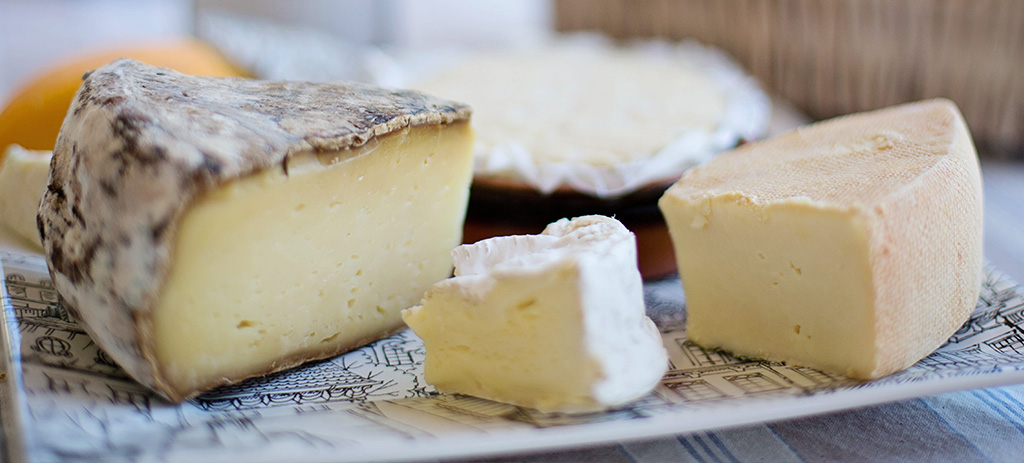Greetings, cheese enthusiasts and dairy daredevils! Today, we’re diving deep into the world of cheese alternatives that will make you say, “Gouda-bye” to your usual picks. Whether you’re feeling a little blue or just want to spice up your cheese board, we’ve got you covered!
1. If you like Cheddar, try Gouda.

Gouda Cheese Find it here.
Cheddar, meet your edgier, Dutch cousin – Gouda. While cheddar might be the classic cheese that goes with everything, Gouda is the rebel that brings a little more drama to the plate. It’s like cheddar decided to put on some wooden shoes and take a stroll through a tulip garden. Gouda: for when you want your cheese to have a little more gouda-mn attitude.
Gouda: A Glimpse into Dutch Delight:
Originating from the Netherlands, Gouda is a semi-hard cheese that has gained international acclaim for its distinctive flavour and smooth texture. Traditionally made from cow’s milk, Gouda undergoes a meticulous ageing process, resulting in a cheese that can range from mild and creamy to bold and nutty.
Flavour Profile:
Gouda boasts a milder taste compared to cheddar, making it an approachable option for those who find the sharpness of cheddar overwhelming. Its subtle sweetness and nutty undertones add depth to various dishes without overpowering other flavours.
As you embark on your journey of cheese exploration, consider Gouda as a worthy alternative to cheddar. Its mild flavour, smooth texture, and versatility in the kitchen make it a delightful addition to various dishes.
2. If you like Cream Cheese, try Ricotta.

Ricotta Cheese Find it here.
Cream cheese and ricotta have always been the power couple of the cheese world. They spread smoothly, blend effortlessly, and make bagels feel loved. But what if we told you that you can have the best of both worlds? Introducing “Rico-Cream” – the lovechild of ricotta and cream cheese. It’s so smooth, it makes butter jealous. Slather it on your morning toast and start your day on a cheesy note!
Understanding Ricotta:
Ricotta, an Italian whey cheese, has gained popularity for its mild flavour and smooth texture. Traditionally made from the whey leftover during the production of other cheeses, ricotta offers a unique profile that makes it a versatile ingredient in both sweet and savoury dishes. Unlike cream cheese, ricotta is lighter and lower in fat, making it an excellent choice for those looking to reduce their calorie and fat intake.
The Creaminess of Ricotta:
One of the standout features of ricotta is its creamy consistency, which makes it a viable alternative to cream cheese in a variety of recipes. Whether you’re spreading it on a bagel, incorporating it into dips, or using it in desserts, ricotta brings a luscious texture without the heaviness associated with traditional cream cheese.
3. If you like Feta, try Chèvre.

Chèvre Cheese Find it here.
Feta is crumbly, tangy, and perfect for salads. But let’s not forget its French cousin, chèvre. Chèvre is the sophisticated sibling who went to culinary school and now pairs perfectly with everything from honey to figs.
Chèvre, the French word for goat, refers to cheese made from goat’s milk. This cheese has gained popularity for its distinct flavour profile, creamy texture, and versatility in various culinary applications. While it may not be an exact replica of feta cheese, Chèvre offers a unique alternative that can add a delightful twist to your dishes.
Flavour Profile:
Chèvre boasts a tangy and earthy flavour, with subtle notes of sweetness that set it apart from the saltier taste of feta. The richness of goat’s milk lends Chèvre a creaminess that can be both satisfying and indulgent. Its flavour complexity makes it a suitable substitute for feta, especially in recipes where a milder and more nuanced taste is desired.
Texture and Consistency:
One of the remarkable qualities of Chèvre is its creamy and smooth texture. While feta is known for its crumbly and slightly grainy consistency, Chèvre provides a luxurious creaminess that can effortlessly enhance salads, dips, and spreads. The spreadable nature of Chèvre makes it an excellent choice for incorporating into both sweet and savoury dishes.
Versatility in Cooking:
Chèvre’s versatility extends beyond being a mere feta alternative; it can be a star ingredient in a wide range of dishes. Crumble it onto salads, spread it on crackers, or use it as a creamy filling for pastries. Additionally, Chèvre can be incorporated into pasta dishes, omelettes, and even desserts, showcasing its adaptability in various culinary creations.
4. If you like Swiss Cheese, try Raclette.

Raclette Cheese Find it here.
Swiss cheese has always been the cool, neutral guy at the cheese party. Enter raclette, the cheese that’s like Swiss, but with a twist – and a melt. Forget about fondue; raclette is the ultimate cheese for cosy gatherings. Just melt it on everything and voila – you’ve got a gooey, melty masterpiece.
Firstly, let’s address the elephant in the room – or should we say, the cow on the alp? Yes, Racelette is made from cow’s milk, just like its more famous Swiss relatives. But unlike those cheeses, Racelette isn’t afraid to step out from the shadow of the Alps and into the limelight.
Understanding Raclette:
Raclette, a semi-hard cheese originating from Switzerland, has earned its place among cheese connoisseurs for its distinctive taste and melting qualities. Traditionally made from cow’s milk, Raclette boasts a smooth, creamy texture and a mild, nutty flavour profile. The cheese is aged for about three to six months, allowing it to develop its unique characteristics.
Raclette’s Melt-in-Your-Mouth Magic:
One of the key features that set Raclette apart is its exceptional melting ability. This quality has made Raclette a star in the world of cheese, particularly in Swiss and French cuisines. The cheese is often melted and scraped onto a variety of accompaniments, creating a delectable dish known as Raclette.
Whether you’re melting it, grating it, or simply nibbling on it with a glass of Swiss wine, Racelette is the Swiss cheese alternative that’s taking the dairy world by storm.
5. If you like Mozzarella, try Provolone.

Provolone Find it here.
Let’s start with the basics. Hailing from Southern Italy, Provolone is a semi-hard cheese that boasts a unique taste profile. It has a distinct nutty and sharp flavour, making it a fabulous substitute for mozzarella. While mozzarella might be the go-to for that classic pizza pull, Provolone steps in with a richer, more robust taste that can elevate your pizza experience to new heights.
Texture and Melting Qualities:
One of the key reasons provolone shines as a mozzarella alternative is its texture and melting qualities. Provolone has a smooth and elastic texture, similar to mozzarella, which makes it perfect for dishes that require gooey, melted goodness. Whether you’re making pizza, lasagna, or a classic caprese salad, provolone’s ability to melt beautifully adds a rich and satisfying element to your culinary creations.
Flavour Profile:
Provolone’s flavour profile is another reason why it makes a fantastic mozzarella substitute. While mozzarella is known for its mild and fresh taste, provolone offers a slightly sharper and more robust flavour. This can add an exciting depth to your dishes, especially for those who appreciate a more pronounced cheese taste.
5. If you like Parmesan, try Pecorino.

Pecorino Cheese Find it here.
Parmesan may have the reputation, but Pecorino is here to prove that it’s no sidekick. Pecorino, made from sheep’s milk, is the maverick in the cheese universe, ready to steal the spotlight from its more conventional counterparts.
First things first, let’s address the taste test. Parmesan may have its nutty, salty charm, but Pecorino adds a rebellious kick to the mix. It’s like Parmesan went on a wild vacation and came back with a tattoo and a leather jacket.
Picture Pecorino as the cool cousin who’s not afraid to break the rules. It’s bold, tangy, and slightly gamey—perfect for those who like their cheese with a side of adventure. Parmesan, meet your match!
Pairing Pecorino:
Now, onto the serious business of pairing. While Parmesan might play it safe with wine, Pecorino wants to dance on the wild side. Imagine this rebel cheese cosying up to a robust red wine, whispering tales of its sheepish escapades.
And let’s not forget about the unconventional pairings – Pecorino with honey or a drizzle of balsamic glaze. Who knew cheese could be so adventurous?
The Rebellion Spreads:
It’s time for cheese enthusiasts to embrace the rebellion and let Pecorino shine. No more playing second fiddle; it’s time to make room for the sheepish star at your dinner table.
So, the next time you’re faced with a Parmesan predicament, fear not. Pecorino is ready to step in, not as a mere substitute but as a flavourful alternative that might just make you question your loyalty to the Parmesan establishment.
In conclusion, don’t be afraid to venture into the wild and wacky world of cheese alternatives. Who knows, you might just discover a new favourite that leaves your taste buds doing the cha-cha. So, grab your cheese knives, put on your cheese-eating pants, and let the fromage festivities begin! After all, life’s too short for boring cheeses – embrace the cheese-citement!

